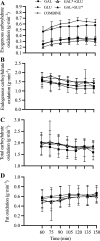Oxidation of independent and combined ingested galactose and glucose during exercise
- PMID: 36201325
- PMCID: PMC9639767
- DOI: 10.1152/japplphysiol.00105.2022
Oxidation of independent and combined ingested galactose and glucose during exercise
Abstract
Coingestion of glucose and galactose has been shown to enhance splanchnic extraction and metabolism of ingested galactose at rest; effects during exercise are unknown. This study examined whether combined ingestion of galactose and glucose during exercise enhances exogenous galactose oxidation. Fourteen endurance-trained male and female participants [age, 27 (5) yr; V̇o2peak, 58.1 (7.0) mL·kg-1·min-1] performed cycle ergometry for 150 min at 50% peak power on four occasions, in a randomized counterbalanced manner. During exercise, they ingested beverages providing carbohydrates at rates of 0.4 g.min-1 galactose (GAL), 0.8 g.min-1 glucose (GLU), and on two occasions 0.8 g.min-1 total galactose-glucose (GAL + GLU; 1:1 ratio). Single-monosaccharide 13C-labeling (*) was used to calculate independent (GAL, GLU, GAL* + GLU, and GAL + GLU*) and combined (GAL* + GLU*, COMBINE) exogenous-monosaccharide oxidation between exercise. Plasma galactose concentrations with GAL + GLU [0.4 mmol.L; 95% confidence limits (CL): 0.1, 0.6] were lower (contrast: 0.5 mmol.L; 95% CL: 0.2, 0.8; P < 0.0001) than when GAL alone (0.9 mmol.L; 95% CL: 0.7, 1.2) was ingested. Exogenous carbohydrate oxidation with GAL alone (0.31 g·min-1; 95% CL: 0.28, 0.35) was marginally reduced (contrast: 0.05 g·min-1; 95% CL: -0.09, 0.00007; P = 0.01) when combined with glucose (GAL* + GLU 0.27 g·min-1; 0.24, 0.30). Total combined exogenous-carbohydrate oxidation (COMBINE: 0.57 g·min-1; 95% CL: 0.49, 0.64) was similar (contrast: 0.02 g·min-1; 95% CL: -0.05, 0.09; P = 0.63) when compared with isoenergetic GLU (0.55 g·min-1; 95% CL: 0.52, 0.58). In conclusion, coingestion of glucose and galactose did not enhance exogenous galactose oxidation during exercise. When combined, isoenergetic galactose-glucose ingestion elicited similar exogenous-carbohydrate oxidation to glucose suggesting galactose-glucose blends are a valid alternative for glucose as an exogenous-carbohydrate source during exercise.NEW & NOTEWORTHY Glucose and galactose coingestion blunted the galactosemia seen with galactose-only ingestion during exercise. Glucose and galactose coingestion did not enhance the oxidation of ingested galactose during exercise. Combined galactose-glucose (1:1 ratio) ingestion was oxidized to a similar extent as isoenergetic glucose-only ingestion during exercise. Galactose-glucose blends are a viable exogenous carbohydrate energy source for ingestion during exercise.
Keywords: metabolism; nutrition; physical activity; substrate oxidation; sugars.
Conflict of interest statement
O.J.O. receives funding from the Biotechnology and Biological Sciences Research Council (United Kingdom) as part of an iCASE studentship (Midlands Integrative Biosciences Training Partnership), in partnership with Volac International Ltd (United Kingdom). G.A.W. has received research funding and/or has acted as a consultant for GlaxoSmithKline Ltd (United Kingdom), Sugar Nutrition UK, Lucozade Ribena Suntory Ltd (United Kingdom) and Volac International Ltd. D.S.R. has received consultancy research funds from Frucor Suntory Beverages (New Zealand), Zespri Ltd (New Zealand), and Lucozade-Ribena-Suntory Ltd (United Kingdom).
Figures




Similar articles
-
Postexercise muscle glycogen synthesis with glucose, galactose, and combined galactose-glucose ingestion.Am J Physiol Endocrinol Metab. 2023 Dec 1;325(6):E672-E681. doi: 10.1152/ajpendo.00127.2022. Epub 2023 Oct 18. Am J Physiol Endocrinol Metab. 2023. PMID: 37850935 Free PMC article. Clinical Trial.
-
Preexercise galactose and glucose ingestion on fuel use during exercise.Med Sci Sports Exerc. 2012 Oct;44(10):1958-67. doi: 10.1249/MSS.0b013e318258bf85. Med Sci Sports Exerc. 2012. PMID: 22525771 Clinical Trial.
-
Oxidation of combined ingestion of glucose and fructose during exercise.J Appl Physiol (1985). 2004 Apr;96(4):1277-84. doi: 10.1152/japplphysiol.00974.2003. Epub 2003 Dec 2. J Appl Physiol (1985). 2004. PMID: 14657042
-
Fructose-Glucose Composite Carbohydrates and Endurance Performance: Critical Review and Future Perspectives.Sports Med. 2015 Nov;45(11):1561-76. doi: 10.1007/s40279-015-0381-0. Sports Med. 2015. PMID: 26373645 Review.
-
The use of carbohydrates during exercise as an ergogenic aid.Sports Med. 2013 Nov;43(11):1139-55. doi: 10.1007/s40279-013-0079-0. Sports Med. 2013. PMID: 23846824 Review.
References
Publication types
MeSH terms
Substances
Grants and funding
LinkOut - more resources
Full Text Sources
Miscellaneous

